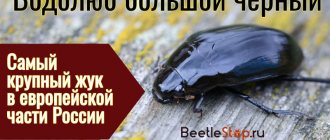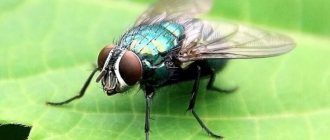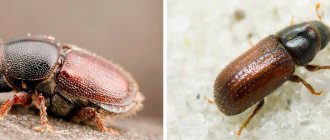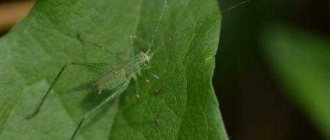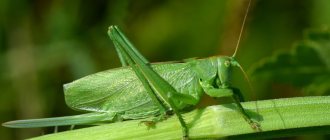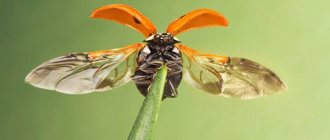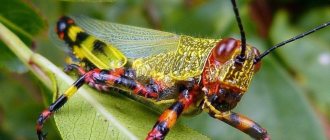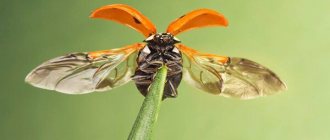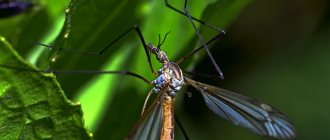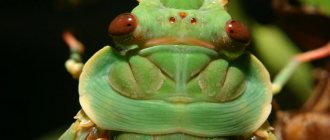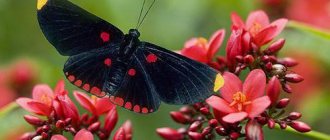Also on topic:
INSECTS
The beetles are distributed almost throughout the world and are found in a wide variety of habitats, including under rocks and logs, on the forest floor, in gravel along river banks, and in fresh water bodies. The larvae of many Coleoptera live in wood or under the bark of trees, and in some species, in the decaying remains of animals. Representatives of several families form a symbiosis with ants.
Almost any organic material can serve as food for one or another group of Coleoptera. Many beetles feed on plants (phytophagous); some prey on insects, snails or other small invertebrates. A number of species feed on dead or decaying tissues of plant or animal origin.
Structure and physiology.
Also on topic:
SYSTEMATICS OF ANIMALS
The order Coleoptera includes both the largest and smallest insects. The Hercules beetle (Dynastes hercules) from Central America can reach a length of 15 cm, including a long horn on the prothorax, and some small species are no longer than 0.5 mm. The body of adult beetles consists of three main parts: the head, thorax and abdomen. Although this body partition is typical for all insects, some features make it possible to distinguish Coleoptera from representatives of other groups.
On the head there are developed antennae (antennae, tassels) and mouthparts - most often of the gnawing type with horizontally moving parts. It consists of three pairs of appendages: mandibles (lower jaws), upper jaws and lower lip. The mandibles are solid, located above or in front. Behind or under them are articulated lower jaws, each of which bears a palp on the outer side, also consisting of 4 or 5 segments. The lower lip is similar in structure to a pair of jaws fused together along the midline, but its palps are usually three-jointed. In phytophagous beetles, the mandibles are usually directed downward (orthognathic type of head), while in predatory species they are directed forward (prognathous type).
Also on topic:
Lamelatinate
The chest, the part of the body adjacent to the head, consists of three segments. The first - the prothorax - bears only a pair of legs. Beetles usually have a larger prothorax than most other insects. The second segment (mesothorax) bears, in addition to a pair of legs, a pair of hard or leathery elytra. The third segment (methothorax) contains the third pair of legs and membranous hind wings, which can fold so that they fit completely under the elytra, but are sometimes absent altogether.
Behind the chest is the abdomen, consisting of several segments of a similar structure, covered on top by elytra. Along the midline of the abdomen from the dorsal side (where the elytra meet), a straight line seems to be drawn. With rare exceptions, it is characteristic of all beetles.
During flight, the elytra are either raised and create lift, or remain folded even after the hind wings have spread. Although many beetles simply need to spread their wings and jump up to fly, some larger and heavier species must climb trees and warm up in the sun to do so. It is widely believed that the prosperity of insects as a group is due to their ability to fly. However, the most successful group among them are beetles, which for the most part fly worse than representatives of many other orders. At the same time, the elytra and thick cuticle perfectly protect them from mechanical damage and loss of moisture. In all likelihood, it is these factors that give them their advantages.
The cuticle of beetles, which plays the role of both body integument and exoskeleton, is much tougher and thicker than that of most other insects. Most often it is shiny, brown or black, but in some species it can be bright and even covered with colored dots, spots, stripes or a complex pattern that imitates the color of the environment (protective coloration). Since the body coverings are hard, the mobility of the beetles is limited, and, having turned upside down on a smooth surface, they can hardly return to a normal position on their own. To overcome this situation, many species, such as click beetles, use special mechanisms.
The internal structure of Coleoptera is typical for the class of insects. The heart is located just below the cuticle along the midline of the back, and the nerve cord runs along the underside of the body. The circulatory system is not closed, i.e. blood (more precisely, hemolymph) is not enclosed in veins and arteries, but freely washes the internal organs. Beetles breathe air, which penetrates inside through spiracles (stigmas) on the sides of the body and reaches all tissues through a system of branched tubes - the so-called. trachea.
Some beetles, such as those from the weevil family, can reproduce parthenogenetically, without fertilization. The males of these species are unknown. However, most reproduce sexually. Males and females can differ significantly in appearance (sexual dimorphism) and numbers. In bark beetles, for example, there are up to 60 females for every male.
During mating, the male usually releases enough sperm to fertilize all the eggs the female can lay in her lifetime. Sperm are stored in the female's body in a special sperm receptacle, and fertilization occurs immediately before each egg laying. Males of some species produce sperm in special cases, the so-called. spermatophores, which are transmitted to females during mating.
Compared to most other insects, beetles' eyes are less developed (with the exception of predatory species), so they navigate mainly using their well-developed sense of smell. Olfactory receptors are located on antennae, which come in a wide variety of shapes. For example, in dung beetles, the end segments of the antennae are expanded in the form of plates and can move apart and fold like a fan.
Beetles hear, as a rule, poorly. However, some of them can produce a kind of squeaking sound due to the friction of body parts against each other or make sounds by lightly tapping their heads on a hard surface. These same species are also capable of perceiving the sounds produced, and their hearing is better developed than that of other Coleoptera. Grinder beetles are widely known to “tick” like a clock, tapping their heads on the wood in which they make passages.
Internal structure of the cockchafer
The type of mouthparts is gnawing.
Digestive system
The adult cockchafer feeds on the leaves of trees and shrubs.
With the pointed ends of the upper jaws, it bites off small pieces from the leaf, and with the jagged edges of the lower jaws it crushes them.
Swallowed food enters the esophagus and then the stomach. The stomach has chitinous teeth with which food is ground. Its final digestion and absorption of nutrients occurs in the intestines. Remains of food are eliminated through the anus.
Circulatory system
The circulatory system, like that of all arthropods, is not closed.
Blood directly washes the internal organs and tissues while in the body cavity, transferring nutrients to them and carrying harmful waste products to the excretory organs. It does not participate in the transfer of oxygen and carbon dioxide, that is, in respiration. Its movement is ensured by the work of the heart - a longitudinal muscular tube located in the dorsal part above the intestines.
The heart, pulsating rhythmically, drives blood to the head of the body.
Backflow is prevented by the heart valves. When the heart expands, blood enters it from the back of the body through its side openings, which are equipped with valves that prevent blood from flowing back.
In the body cavity, unlike the heart, blood flows from the front end to the back, and then, entering the heart as a result of its pulsation, it is again directed to the head.
Respiratory system
The respiratory system is a dense network of branched internal tubes - tracheae, through which air, entering through the external spiracles, is delivered directly to all internal organs and tissues.
If you lift the elytra of the beetle and spread the thin translucent wings, then along the edge of the dorsal side of the abdomen, small holes are visible on each segment - spiracles.
Excretory system
The excretory system is a bundle of thin tubes, the so-called Malpighian vessels, located in the body cavity.
They are closed at the tops, and open at the bases into the intestines.
Metabolic products are filtered out by the entire surface of the Malpighian vessels, and then inside the vessels they turn into crystals.
Then they enter the intestinal cavity and, together with undigested food debris, are excreted from the body. Some harmful substances, especially poisons, accumulate and are isolated in the fat body.
Nervous system
The nervous system, like that of all arthropods, consists of a peripharyngeal ring and a ventral nerve cord.
In the head, as a result of the fusion of clusters of nerve cells, the brain is formed.
Reproductive system
The female reproductive system consists of two ovaries, in which eggs are formed.
The ovaries, passing into tubular oviducts, merge at their bases into a single unpaired oviduct, through which mature eggs are released.
In the female reproductive system there is a seminal receptacle - a reservoir into which the sperm of males enters. Mature eggs can be fertilized by these sperm.
The reproductive organs of the male are two testes that pass into the vas deferens, which unite into an unpaired ejaculatory duct, which serves to excrete sperm.
Life cycle.
Beetles belong to a group of insects called Endopterygota. Like its other representatives, their wings at the larval stage are laid inside the body and at this time are not visible from the outside. The life cycle of most beetles is as follows: egg - larva, which molts several times as it grows, - pupa - adult insect (imago). Larvae and adults differ greatly in structure and sometimes in lifestyle. Moreover, in some families, the larvae noticeably change shape with each moult and, depending on their age, look completely different.
Beetle eggs are usually white. The smallest of them are almost invisible, while the largest ones reach a length of 3 mm. Many species deposit them in wood or under the bark of trees, some on plant leaves, and several groups deposit them in the carcasses of large animals in various stages of decomposition.
Most larvae have a well-developed head and three pairs of thoracic legs. Often at the end of the abdomen they have another pair of appendages similar to legs - pseudopods. However, the larvae that live inside plants can be legless and worm-like. The larval stage ends with transformation into a resting pupa.
Pupation of many Coleoptera occurs inside chambers (“cradles”) in the soil or in wood. The larvae of some weevils pupate in cocoons, which are spun from the adhesive secretion of special glands that hardens in the air, secreted through the anus. During the pupal stage, a complex set of changes occurs that result in the formation of extremely diverse adult beetles (adults). These transformations include the development of imaginal walking legs, wings, antennae and mouthparts. When an adult beetle emerges from the pupa, its wings and elytra straighten, turning inside out, under the pressure of the hemolymph pushed into them. Then the hemolymph is pumped out of them, and the upper and lower layers of the wing stick together, forming a thin plate.
Adult beetles usually live longer than adults of most other insects. Their larvae can also develop very slowly. For example, the larval stage of some click beetles, in which they are called wireworms, lasts at least 12 years before pupation. The larvae of one Indian longhorned beetle lived for 10 years in captivity, although the adult beetles of this species are short-lived. In the laboratory, the adults of one large darkling beetle did not die for 9 years, but species are known whose adult stage lasts only a few days.
Reproduction and development
After fertilization, the female cockchafer burrows into the soil and lays eggs there.
Larva
Larvae emerge from the eggs at the end of summer.
Neither in appearance nor in their way of life they are at all similar to adult beetles. The thick whitish body of the larva is arched and covered with a soft chitinous cover. More dense yellowish-brown chitinous covering on the large head and three pairs of legs.
The wings of the larva are not developed. The spiracles are visible on the sides of the body. In the back of the abdomen, an intestine filled with earth is visible: young larvae feed on humus.
In autumn, the larvae go deep into the soil and overwinter. In the spring of next year they rise to the soil surface, where during the summer they eat the roots of herbaceous plants and pine seedlings. The larvae spend the winter again deep in the soil. The following summer (third year of development), the grown larvae eat the roots of bushes and trees.
Doll
Having overwintered for the third time and grown greatly, at the end of spring the larva goes deeper into the soil and, shedding its larval cover, turns into a pupa.
It looks like an adult insect. On it you can distinguish a head with mouthparts and antennae, compound eyes, legs folded on the chest of the pupa, and small wings are noticeable. The chitinous cover is quite dense, but uncolored.
The pupa can move its abdomen slightly, but is not able to move or feed. This is a resting stage in development. Under the chitinous cover of the pupa, complex changes occur due to the nutrients accumulated by the larva, leading to the development of all organs of the adult insect. By autumn, the skin of the pupa bursts, and an adult beetle emerges from it with soft, colorless covers, which soon harden and acquire a characteristic color.
The beetles remain overwintering in the ground and come to the surface only in the spring of next year.
Cicindelidae
(horses). Described approx. 1300 species of jumping beetles. These are agile and attractive insects, often brightly colored blue, green or red with a metallic sheen, especially on the underside. The upperparts of the body are usually sandy or reddish in color with a clear pattern. Most often, horses can be seen in sandy areas, especially in hot and sunny weather. They react sensitively to the approach of a person, taking off into the air and landing several meters further from the stranger, and then turn around and begin to watch him again. Horses run fast and are able to protect themselves with long, sharp mandibles. Their larvae live in burrows dug underground up to one and a half meters long.
What kind of lifestyle and diet
Coleoptera lead an active lifestyle. Most insects feed on plants and can be pests. There are also predators. Meet:
- saprophages that consume putrefactive remains;
- coprophages, preferring animal feces;
- necrophages that eat carrion.
Beetles stock up in burrows to feed their young or survive in times of famine. Some representatives at the adult stage live without food.
Several subspecies lead a parasitic lifestyle. They lay eggs on the victim. Young individuals eat the representative from the inside and eat away all the organs.
Most representatives eat greens
Carabidae
(ground beetles). Described approx. 20,000 species of these beetles; some of them reach a length of 90 mm. Characteristic features of ground beetles as predatory insects include long legs, large bulging eyes and forward-pointing sharp mandibles. Their larvae are also predators, but, like adults, they can also feed on animal corpses and other decaying organic matter. One group of ground beetles eats exclusively seeds.
The color of these beetles is usually black, brown or metallic, and the elytra are often streaked with longitudinal lines. Ground beetles can be found on the surface of the ground or in the soil, especially along rocky banks of streams and rivers, as well as in rotting wood. In some species, the hind wings are absent and the elytra are fused. However, many tree-dwelling tropical species have well-developed membranous wings and are excellent fliers. Most ground beetles can secrete a foul-smelling liquid from the rear end of their body, which probably serves to scare off enemies. In bombardier beetles, it immediately turns into steam, taking the form of a dense cloud, and its ejection is accompanied by a rather loud shooting sound.
Belly
Behind the chest is the body, which consists of several parts and is covered by elytra on top. Representatives of Coleoptera have a cuticle, which acts as an external skeleton and body cover. As a rule, it is thicker and tougher than that of many other insects. There are black, brown, shiny colors. And in some beetles it is covered with colored spots, stripes or patterns, similar to the natural environment in which it lives.
The mobility of Coleoptera is very limited due to the fact that the integument of the body is rigid, therefore, if a beetle turns upside down on a flat surface, then in most cases it will not be able to return to its original position on its own. The hard cuticle, as well as the elytra, perfectly protect the insect from moisture loss and mechanical damage.
Dytiscidae
(swimmers). Known approx. 2100 species of these beetles. Both larvae and adults live in water. Adult beetles have a smooth, streamlined body. They are usually black or dark brown, sometimes with longitudinal stripes on the elytra. In many species of swimming beetles, the males have large, rounded pads on their front legs that help hold the female during mating. The larvae of diving beetles prey on tadpoles, small fish and insects of other species. They grab prey with long sickle-shaped mandibles, inside of which there is a channel that opens with a hole at the top. When the mandibles penetrate the prey, digestive juice is injected into its body through these channels. Under the influence of its enzymes, the tissues of the prey are liquefied and then absorbed by the beetle through the same channels. Thus, digestion occurs outside the swimmer's body.
Weevil or elephant
The species is divided into 60,000 subspecies. Insects differ in body shape. For example, it can be cylindrical or in the form of a hemisphere. Weevils have different colors, they can be black, yellow-brown. The pictures show different types of elephant insects.
The most common species is the rice weevil. His body is elongated, slightly swollen, beautiful, because it has a characteristic shine. The chitinous covers of the insect are brown, the elytra consist of thin grooves. The weevil lives in Europe, Asia, Austria, America and Africa.
Silphidae
(dead eaters). Described approx. 600 species of these beetles. The most famous members of the family with a black and orange pattern on the elytra are called burying beetles. They lay eggs on the carcasses of small animals, which they then bury in the ground (“bury”). Burying it protects the corpse from drying out during the period when the larvae feed on it. Unlike brightly colored burying beetles, some carrion beetles are black, with a dull, rough body surface. Species living in anthills and eyeless cave forms are known.
Coccinellidae
(ladybugs). Described approx. There are 3800 species of this family. Although ladybugs are predators, in appearance they bear little resemblance to predatory insects: they have neither long legs nor large bulging eyes. This may be due to the fact that most of them hunt sedentary prey, such as scale insects, other homoptera and aphids. As a rule, ladybugs have a wide, rounded body ranging from 0.25 to 1.3 cm in length. The elytra are often red or orange with black dots, and the antennae are usually somewhat club-shaped. The paws are adapted for living on plant leaves. They are four-segmented, but appear three-segmented. In the fall, some species climb into houses where they remain for the winter. Others migrate in large groups to mountainous areas and spend the winter in caves or piles of stones. The larvae are covered with longitudinal rows of peculiar tubercles and a distinct pattern of black spots. Ladybugs often pupate on the food plants of their prey, hanging upside down.
The importance of beetles in nature and for humans
The large number of animal species provides a very broad role in the ecosystem.
- Many beetles and their larvae are involved in soil formation and wood processing. Some of them utilize weakened tree samples and speed up the decomposition process.
- The economic importance of individuals is great. Many are helpful in the fight against pests and weeds. Some even introduce them on purpose.
- Agricultural pests There are a lot of these representatives. They affect grasses, trees, fruit trees, conifers, leaves and buds. They often eat stems and fruits.
- People's neighbors . A number of species prefer to live in people's homes. They can feed on leather, paper, grocery supplies and dried fruits. Often affects wood.
- Human health . Many species secrete a defense mechanism in the form of geolymph. It can cause an abscess, burn or itching on the human body, and possibly cause distress. There were manifestations of allergies.
- Cultural parts . Some people often found beetles in their myths and symbols, and some were credited with magical properties. They were often seen in films and on classic paintings.
- Collecting . Private collections can number several thousand individuals. They select them by color or type, focusing on aesthetics. There are also scientific ones, including for cabinets of curiosities.
Tenebrionidae
(darkling beetles). More than 10,000 species of darkling beetles are known. The appearance of representatives of this family is very typical for beetles in general. They are approximately 1.3 to 5 cm long and are usually brown or black in color. Many species have clearly protruding stripes along the elytra. Darkling beetles can be distinguished by two clearly visible features: the tarsi of their hind legs consist of only 4 segments, while the front two pairs have five, and the posterior edge of the eye often continues as a thick ridge on the side of the head. Some darkling beetles live in semi-deserts, many live in the soil or on its surface. The larvae of a number of soil species harm plants like wireworms, which they resemble in appearance; they are called false wireworms.
General characteristics of the class
They live in soil, water, plant tissues, animals and humans.
Fertility:
- queen bee - 1,500,000 eggs in her entire life (lives 5 years).
- termite queen - 10,000,000 eggs per life (lives 10 years).
Benefit:
- pollinate plants;
- destroy field pests;
- gardens and vegetable gardens.
Harm:
- blood-sucking (affect milk yield);
- carry pathogens from animals to humans (lice - typhus, relapsing fever; mosquitoes - malaria; flies - eye diseases).
Types of mouthparts:
- gnawing - beetles, cockroaches, grasshoppers;
- sucking - butterflies;
- piercing - mosquito;
- licking - fly;
- gnawing-licking - bees, gadflies, wasps, bumblebees, hornets.
Vision is complex (faceted).
A person distinguishes about 60 individual colors; bees see yellow, blue-green, blue, ultraviolet (butterflies see red).
The shape of objects is distinguished - predatory (dragonflies, tyrs...); social (ants, bees, wasps).
The sense of smell is on the antennae (butterfly - 2-3 km).
Taste organ on the mouth parts (jaws, lips, palps).
Just like humans, they distinguish between sweet, sour, salty, and bitter.
Sense organs are well developed and provide insects with great information about the external environment.
Elateridae
(nutcrackers). Described approx. 7000 species of these beetles. Once on their backs, they can jump into the air, sharply arching their body, and land in the correct position. Because of the click that accompanies their turning over, they got their popular name. Most click beetles are brown, black or green with a metallic tint. Their antennas are usually serrated. The elytra are grooved and are usually equipped with a notch along the anterior edge into which the process of the prothorax extends: this adaptation provides the ability to jump with a characteristic click. However, not all members of the family have such a mechanism.
Adults so-called fire-bearing click beetles from tropical America have brightly luminous organs on the sides of the chest, similar in structure to those present in species of another family - fireflies (Lampyridae). The eggs and larvae of firecrackers also glow. Long, rounded in cross-section, the larvae of click beetles have durable integuments of yellow or brown color. Most of these “wireworms” live in the soil, some live under the bark of trees. Larvae of several species can cause significant damage by damaging the roots of agricultural plants.
Habitat
Beetles are found all over the world, they live in forests, steppes, deserts, and tundra. Insects rarely live where there is permanent snow; they are not found in Antarctica. Beetles are found:
- in black soils;
- in the bark of trees;
- in deciduous cover.
Some species inhabit deserts. Such insects are adapted to different environmental conditions. They forage for food at night.
Most representatives of the Coleoptera order prefer to drink fresh and slightly salted water.
Dermestidae
(carpet beetles). Described approx. 600 of their species. Almost all skin beetles are relatively small, often spotted. The spots are associated with thin scales that partially cover the body, which can be one or more colors. The antennae are short, club-shaped, capable of inserting into special grooves on the prothorax. The color of the heavily pubescent larvae ranges from reddish-brown to black. They can be found on decomposing animal carcasses, in storerooms, under carpets, in woolen clothing, furs or leather, and can seriously damage these items. The larvae often molt, and their presence is revealed by accumulations of shed integument. Adult beetles eat the same food as the larvae, but during settlement, adults feed on pollen, so they are sometimes found on flowers.
Chrysomelidae
(leaf beetles). Described approx. There are 25,000 species of this family, one of the largest in the order of beetles. Although outwardly its representatives are somewhat similar to ladybugs, leaf beetles can be distinguished by an additional leg segment (it seems that there are 4 of them, but in fact there are 5) and a plant diet. These beetles are often brightly colored, sometimes have a metallic sheen, and often have a striped pattern. Some species known as flea beetles or ground flea beetles (subfamily Halticinae) are good jumpers. The mechanism of their jumping is the same as that of grasshoppers, due to the fundamental similarity in the structure of the hind legs, which have very thick thighs.
What is the difference between a female and a female?
Males are often smaller. They are capable of having horns, which make them larger in size than females. The front legs of male representatives are spread to the side to capture the partner at the time of mating. There are swollen rear thighs.
In females, horns are absent or replaced by small outgrowths. Males also differ in the length of their mustache. In male representatives they are larger. Wings may be completely absent in females. This is due to a sedentary lifestyle. The elytra are underdeveloped.
Males often have horns
Scarabaeidae
(lamellae). Described approx. 15,000 species of this family. Lamellar beetles have a stocky shape and sizes from very small to very large (for example, the length of the Goliath beetle reaches 11 cm). The antennae are club-shaped, and the segments of the club are usually flattened and elongated into plates connected by the bases, which can move apart like a fan. Many species feed on dung and have a good sense of smell, which is necessary for searching for food. Scarabs make balls from dung, and then, moving backwards, roll them with their hind legs and bury them in loose soil for storage. In Ancient Egypt, these beetles were considered sacred.
Some Indian dung beetles make huge balls of dung and cover them with clay before burying them. When such balls were found in a semi-petrified state, they were sometimes mistaken for stone cannonballs. Adult representatives of another group, beetles, feed on leaves, and their larvae feed on plant roots.
Features of Coleoptera insects
Individuals of this group lead an active lifestyle. They are in constant search of food. Based on the type of food, all beetles are divided into several types:
- phytophages - eat only plant foods;
- predators - feed on food of animal origin;
- saprophages - eat rotting remains;
- necrophages - prefer carrion;
- coprophagous - feed on animal excrement.
A characteristic feature of some types of beetles is the creation of reserves for the cold season. They hide them in their burrows.
Among the representatives of Coleoptera there are entire families that cause serious harm to agriculture. Their larvae develop in the ground for several years, feeding on the roots and trunks of cultivated plants. There are also individuals that eat leaves (weevils, tubeworms) and the upper part of the trunk (bark beetles, borers, etc.).
Convex ground beetle
Coleoptera are characterized by a rich set of manifestations of the instinct to care for offspring. This manifests itself primarily in the preparation of food reserves for future larvae, as well as in caring for laid eggs.
For reference: The ability to make sounds is quite widespread among beetles. It occurs in representatives of various families. Acoustic communication is an important means of communication among individuals of the same species.
Coleoptera are beetles with a wide distribution area. There are certain families in every country. It is worth noting that they inhabit not only land, but also fresh water bodies throughout the globe.
Curculionidae
(weevils, or elephant weevils). Described approx. There are 40,000 species in this family, the largest in the animal kingdom. Its representatives are easily recognized by their elongated “nose” (rostrum); There are species in which it is 3 times longer than the body. Unlike the sucking proboscis of other insects, the rostrum of weevils bears at the end a gnawing mouthpart typical of beetles. In some species, such as the acorn weevil, females use the rostrum to bore into hard fruits and seeds, where they then lay eggs and where their larvae develop. The antennae of weevils are usually geniculate with clubs at the ends and go first to the sides of the head and then forward. The color of most species is dull, black or brown.
CLASSIFICATION
The order of beetles, or Coleoptera, is usually divided into three suborders.
1. Adephaga (carnivores). Mostly predatory beetles with simple thread-like or flagellate antennae, bulging eyes and five-segmented legs. Examples are ground beetles, whirligigs, and diving beetles.
2. Archostemata (archostemata). This is an ancient, once thriving, but now very species-poor group of rare, unusual beetles whose wing tips are curled into a spiral. It unites only two families - Cupedidae and Micromalthidae (they do not have Russian names).
3. Polyphaga (bivorous). An extremely species-rich, diverse group that includes all other beetles, in particular carrion beetles, ladybugs, darkling beetles, click beetles, fireflies, leaf beetles, longhorned beetles, and weevils.
What insects belong to and where they live
The main families of the order and characteristic features are presented in the table.
| Families | The main families include: • carnivorous beetles; • ground beetles; • weevils; • leaf beetles; • barbel. |
| Peculiarities | All insects have common body structure features. The characteristic features of the representatives include: • powerful and miniature body; • presence of hard covers; • the mouth is predominantly of a gnawing type; • membranous wings. |
Coleoptera live everywhere except the Arctic. Tropical representatives are larger and can grow up to 20 cm.
